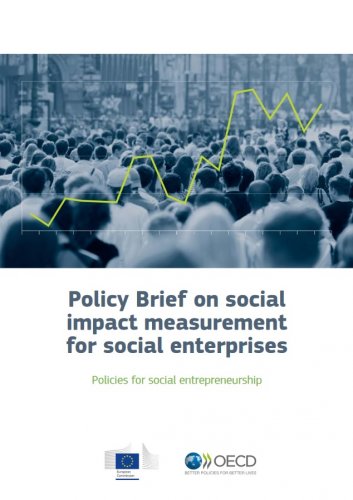Policies for social entrepreneurship
This policy brief on social impact measurement for social enterprises was produced by the OECD and the European Commission. It presents the issues and ongoing debates surrounding social impact measurement and provides concrete examples of measurement methods. It highlights the concept of proportional measurement, in other words balancing up the costs and benefits of the measuring process. The policy brief also looks at guidance and resources for use by social enterprises and how to create a more widespread culture of measurement among stakeholders despite their often limited human and financial resources.
KEY MESSAGES
- Social enterprises may be requested to measure their social impact, especially during the process of raising funds. To do so, they require resources and guidance.
- While private service providers – including social enterprises – need to better identify their social impact in order to attract private investors, social impact measurement should not be primarily driven by their needs. Rather, it should be an ongoing process of dialogue among the different stakeholders involved in the measuring process and interested in its results.
- Social impact measurement is not currently widespread, even though it is gaining traction. One reason is that social enterprises have limited human and financial resources to conduct and use this mechanism.
- Encouraging experimentation and further analysing developments in social impact measurement and social enterprises might contribute to fostering a social impact measurement culture among stakeholders.
- Proportional measurement is an important concept. Only measure if it contributes to decision-making and if the cost of measurement does not outweigh the importance of the decision.
Table of Contents
KEY MESSAGES
WHAT IS SOCIAL IMPACT MEASUREMENT AND WHAT IS ITS PURPOSE?
What is social impact?
Why is it important to measure the social impact of social enterprises?
Academic and non-academic views on social impact measurement
The stakeholder-based approach to social impact measurement
MEASURING THE SOCIAL IMPACT OF SOCIAL ENTERPRISES: A FEW EXAMPLES
CASE 1 – MEASURING THE SOCIAL IMPACT OF WISEs: A COST-BENEFIT ANALYSIS
CASE 2 – MEASURING THE SOCIAL IMPACT OF A SOCIAL ENTERPRISE PROVIDING SERVICES: A RATING APPROACH
CASE 3 – MEASURING THE SOCIAL IMPACT OF A COMMUNITY-BASED SOCIAL ENTERPRISE: THE SAA APPROACH
WHAT ARE THE CHALLENGES TO MEASURING THE SOCIAL IMPACT OF SOCIAL ENTEPRISES?
Conceptual challenges for social impact measurement
Practical challenges
CONCLUSIONS
BIBLIOGRAPHY
Format





